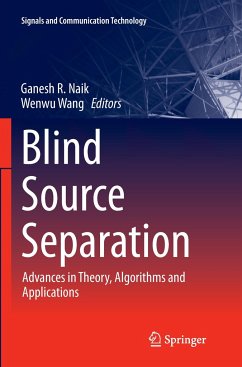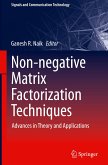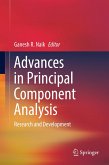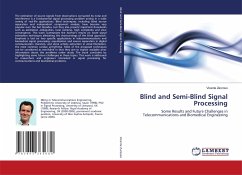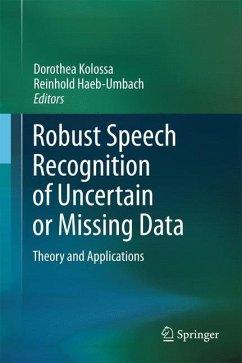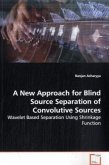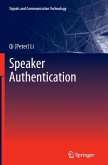Blind Source Separation
Advances in Theory, Algorithms and Applications
Herausgegeben:Naik, Ganesh R.; Wang, Wenwu
Blind Source Separation
Advances in Theory, Algorithms and Applications
Herausgegeben:Naik, Ganesh R.; Wang, Wenwu
- Gebundenes Buch
- Merkliste
- Auf die Merkliste
- Bewerten Bewerten
- Teilen
- Produkt teilen
- Produkterinnerung
- Produkterinnerung
Blind Source Separation intends to report the new results of the efforts on the study of Blind Source Separation (BSS). The book collects novel research ideas and some training in BSS, independent component analysis (ICA), artificial intelligence and signal processing applications. Furthermore, the research results previously scattered in many journals and conferences worldwide are methodically edited and presented in a unified form. The book is likely to be of interest to university researchers, R&D engineers and graduate students in computer science and electronics who wish to learn the core…mehr
![Blind Source Separation Blind Source Separation]() Blind Source Separation74,99 €
Blind Source Separation74,99 €![Non-negative Matrix Factorization Techniques Non-negative Matrix Factorization Techniques]() Non-negative Matrix Factorization Techniques37,99 €
Non-negative Matrix Factorization Techniques37,99 €![Advances in Principal Component Analysis Advances in Principal Component Analysis]() Advances in Principal Component Analysis88,99 €
Advances in Principal Component Analysis88,99 €![Blind and Semi-Blind Signal Processing Blind and Semi-Blind Signal Processing]() Vicente ZarzosoBlind and Semi-Blind Signal Processing38,99 €
Vicente ZarzosoBlind and Semi-Blind Signal Processing38,99 €![Robust Speech Recognition of Uncertain or Missing Data Robust Speech Recognition of Uncertain or Missing Data]() Robust Speech Recognition of Uncertain or Missing Data74,99 €
Robust Speech Recognition of Uncertain or Missing Data74,99 €![A New Approach for Blind Source Separation of Convolutive Sources A New Approach for Blind Source Separation of Convolutive Sources]() Ranjan AcharyyaA New Approach for Blind Source Separation of Convolutive Sources32,99 €
Ranjan AcharyyaA New Approach for Blind Source Separation of Convolutive Sources32,99 €![Speaker Authentication Speaker Authentication]() Qi Li (Peter)Speaker Authentication110,99 €
Qi Li (Peter)Speaker Authentication110,99 €-
-
-
Dr. Ganesh R. Naik works at University of Technology, Sydney, Australia; Dr. Wenwu Wang works at University of Surrey, UK.
- Produktdetails
- Signals and Communication Technology
- Verlag: Springer / Springer Berlin Heidelberg / Springer, Berlin
- Artikelnr. des Verlages: 978-3-642-55015-7
- 2014
- Seitenzahl: 564
- Erscheinungstermin: 11. Juni 2014
- Englisch
- Abmessung: 241mm x 160mm x 36mm
- Gewicht: 1019g
- ISBN-13: 9783642550157
- ISBN-10: 3642550150
- Artikelnr.: 40539814
- Signals and Communication Technology
- Verlag: Springer / Springer Berlin Heidelberg / Springer, Berlin
- Artikelnr. des Verlages: 978-3-642-55015-7
- 2014
- Seitenzahl: 564
- Erscheinungstermin: 11. Juni 2014
- Englisch
- Abmessung: 241mm x 160mm x 36mm
- Gewicht: 1019g
- ISBN-13: 9783642550157
- ISBN-10: 3642550150
- Artikelnr.: 40539814
Quantum independent component analysis and related statistical blind qubit uncoupling methods.- Blind source separation based on dictionary learning: a singularity-aware approach.- Performance study for complex independent component analysis.- Sub-band based- blind source separation and permutation alignment.- Frequency domain blind source separation based on independent vector analysis with a multivariate Gaussian source prior.- Sparse component analysis: a general framework for linear or nonlinear blind unmixing of signals or images.- Underdetermined audio source separation using Laplacian mixture modelling.- Itakura-Saito nonnegative matrix two-dimensional factorizations for blind single channel audio separation.- Source localisation and tracking: a maximum a posterior based approach.-
Section 2: Applications
Statistical analysis and evaluation of blind speech extraction algorithms.- Speech separation and extraction by combining super directive beam forming and blind source separation.- On the ideal ratio mask as the goal of computational auditory scene analysis.- Monaural speech enhancement based on multi-threshold masking.- REPET for background/foreground separation.- Non-negative matrix factorization sparse coding strategy for cochlear implants.- Exploratory analysis of brain with ICA.- Supervised normalisation of large-scale omic datasets using blind source separation.- FebICA: feedback independent component analysis for complex domain source separation of communication signals.- Semi-blind functional source separation algorithm from non-invasive electrophysiology to neuroimaging.
Quantum independent component analysis and related statistical blind qubit uncoupling methods.- Blind source separation based on dictionary learning: a singularity-aware approach.- Performance study for complex independent component analysis.- Sub-band based- blind source separation and permutation alignment.- Frequency domain blind source separation based on independent vector analysis with a multivariate Gaussian source prior.- Sparse component analysis: a general framework for linear or nonlinear blind unmixing of signals or images.- Underdetermined audio source separation using Laplacian mixture modelling.- Itakura-Saito nonnegative matrix two-dimensional factorizations for blind single channel audio separation.- Source localisation and tracking: a maximum a posterior based approach.-
Section 2: Applications
Statistical analysis and evaluation of blind speech extraction algorithms.- Speech separation and extraction by combining super directive beam forming and blind source separation.- On the ideal ratio mask as the goal of computational auditory scene analysis.- Monaural speech enhancement based on multi-threshold masking.- REPET for background/foreground separation.- Non-negative matrix factorization sparse coding strategy for cochlear implants.- Exploratory analysis of brain with ICA.- Supervised normalisation of large-scale omic datasets using blind source separation.- FebICA: feedback independent component analysis for complex domain source separation of communication signals.- Semi-blind functional source separation algorithm from non-invasive electrophysiology to neuroimaging.


